
Article contents

The best way to save for retirement is to make the most of your workplace pension (a pension through work where your employer pays in at least 3% of your salary). Next, open a personal pension online – every time you add money you’ll get a free bonus of 25% from the Government, and your pension will grow tax-free. It’s easy to get started, and we’ve listed the best providers for you too.
Planning for your future? The best way to save for retirement is with a pension, it could be the best decision you ever make.
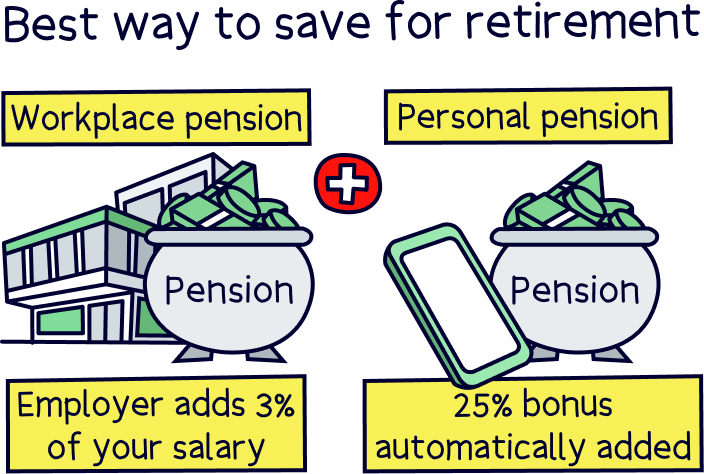
If you are young(er), you might think you have all the time in the world to save, but starting now could mean you can quit your job and retire far earlier, with lots of money for you and your family to live on.
Whatever age you are, don’t put it off any longer, even if you’re 18, or into your 40s, 50s and 60s, start today. Your future self will really appreciate it.
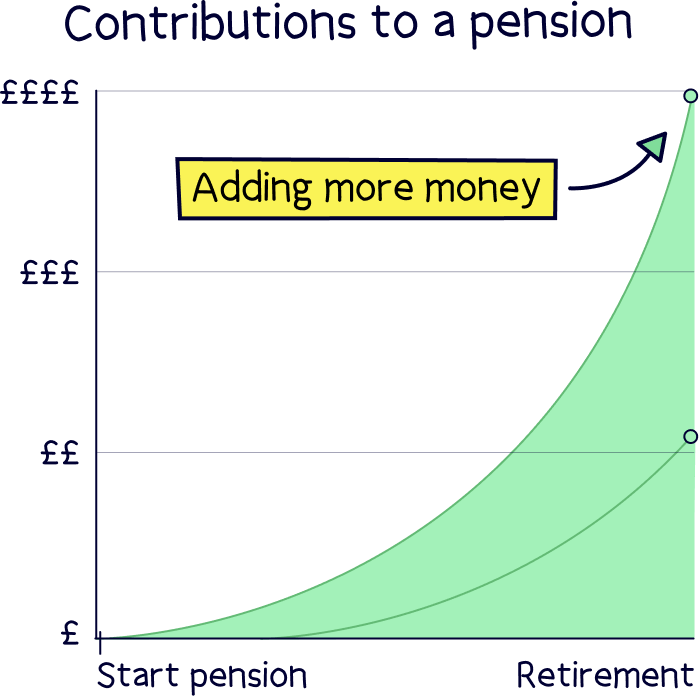
And don’t worry, it’s super easy to do, we’ll show you how to get started, and cover everything you need to know.
If you’re in a bit of a hurry, the best way to save for retirement is with a personal pension, that’s a pension you set up personally yourself, and when you save into it, you’ll automatically get a massive 25% bonus on your contributions from the Government. This is a great idea in addition to a pension from your work (if you’re an employee).
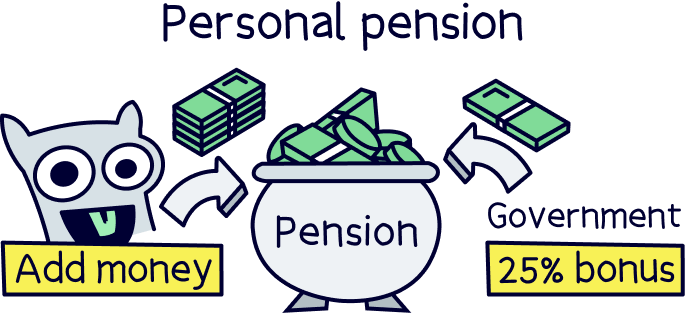
We’ll run through why below, but as a highlight, here’s the best personal pension providers:
Check out PensionBee – it’s easy to use, low cost and has a great track record of growing pensions.
Get £50 added to your pension



PensionBee is our recommended provider – they’ve thought of everything.
Their 5 star rated app (and website) makes it easy to set up and use. You can open a brand new pension, or transfer your existing pensions across (they’ll handle all the paperwork).
Simply pick from an easy to understand range of pension plans, and that’s it, the experts manage everything from there.
It’s low cost, with one simple annual fee. The customer service is excellent, and you’ll get a dedicated account manager for any questions you might have.

And, when the time comes to retire, withdrawing from your pension is easy too.
You can also use them if you're self-employed or a company director.
Great app



A great and easy to use pension. Add money from your bank or combine old pensions into one, (they’ll find lost pensions too).
The customer service is excellent, with support based in the UK.

Beach is an easy to use pension app (and easy to set up), where you just add money and the experts handle everything. It’s all managed on your phone with a great app, and you can see your total pension pot whenever you like.
If you’ve got lost or old pensions, Beach can also find them and move them over too, so you can keep all your retirement savings in one place, and never have to worry about losing them in future.
You’ll get an automatic 25% bonus on the money you add to your pension pot from your bank account (tax relief from the government), which refunds 20% tax on your income, and if you pay 40% or 45% tax, you’ll typically be able to claim the extra back too.
The pension plan (investments) are managed by experts, who are the largest investment company in the world (BlackRock). And they consider things like reducing climate change, meaning your savings could make the world a little better in future too.
You can also save and invest alongside your pension with an easy access pot (access money in around a week), designed for general savings, with the investments managed sensibly by experts too. And money made can be tax-free within an ISA.
Fees: a simple annual fee of up to 0.73% (minimum £3.99 per month).
Minimum deposit: £25
Customer service: excellent
Pros:
Cons:
Check out PensionBee – it’s easy to use, low cost and has a great track record of growing pensions.
Saving for retirement is meant to take a long time, well, your whole working life – there’s no limit to how much you can actually save.
However there are some estimates on how much you should save to provide a comfortable income when you retire (an income of £43,100 per year). It's explained below.
The best way to save is to first use the right savings account (a pension), and we’ll run through why below too, then start saving as soon as you can, and save regularly (super important). We’ll also run through how to get started.
Note: starting saving early in life is great, but don’t panic if you’re older, the important thing to do is start today!
In fact, if you are a bit older, check out our guide to starting a pension at 40 or starting a pension at 50.
Why start early? Well, it's all down to compound interest…
Compound interest is where the money you add makes money (often called interest), and this money makes more money too – and this snowballs over and over, year after year. It can turn small amounts into staggering amounts over time.
Let’s say you had a pension from your job of £10,000 already, and were able to save £220 per month, with your money growing on average 7% per year (historically, how much a pension could typically grow on average).
After 25 years, you’d have a massive £235,470! And 10 years after that you’d have an incredible £511,294.
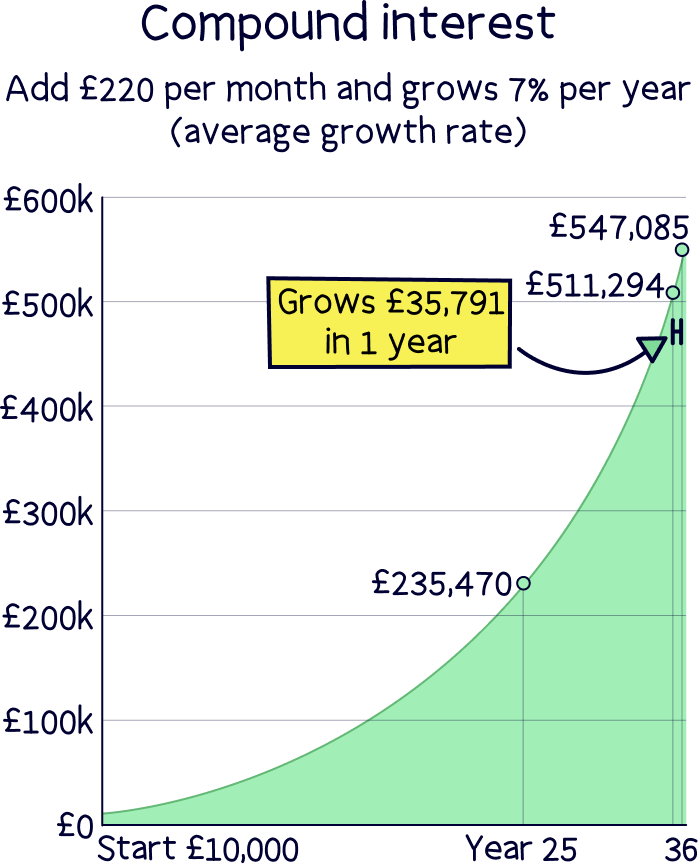
And then just one more year after that, you’d make £35,791 in a single year. Pretty great right? That’s the power of compound interest.
Pensions have so many benefits for long-term retirement saving, that it’s a no-brainer. However, here’s where it gets complicated, as there’s different types of pensions.
In the UK, we have the State Pension (the government pension), and private pensions – and within private pensions, there’s different types again. Don’t panic, we’ll make this bit easy to understand below.
The State Pension is what you’ll get from the Government when you reach the official retirement age (called the State Pension age), which is currently 66, but could rise to 68 in future.
You’ll get this if you’ve made at least 10 years worth of National Insurance contributions, and you’ll get the full amount if you’ve made 35 years worth.
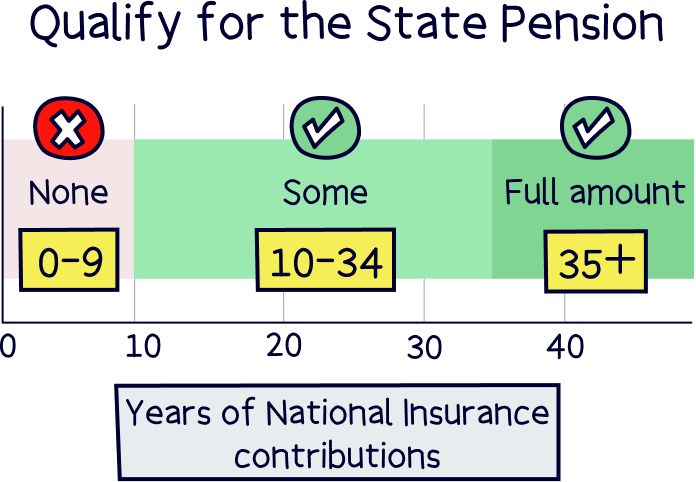
The full State Pension amount you’ll get is currently £230.25 per week. It’s likely you might struggle to live off just this.
Private pensions are pensions that aren’t the State Pension, so pensions that are all yours (private to you), you decide how much to pay into, and when to start taking it (as long as you’re over 55).
There’s two main types of private pensions, a workplace pension, and a personal pension.
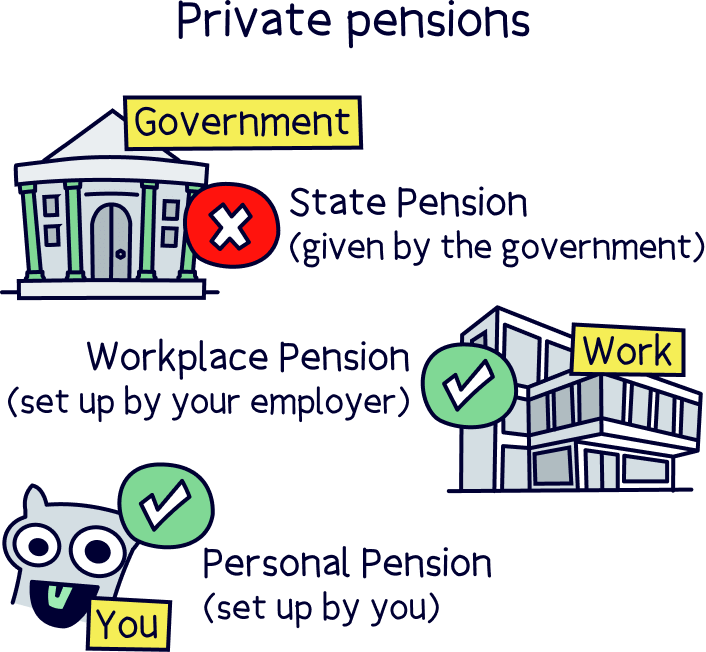
This is the pension you’ll get if you’re employed, and your employer will set this up for you, as part of a scheme called auto-enrolment (so you have to opt out if you don’t want it).
If you pay in 5% of your salary, your employer legally has to pay in at least 3%. It’s like a free pay rise!
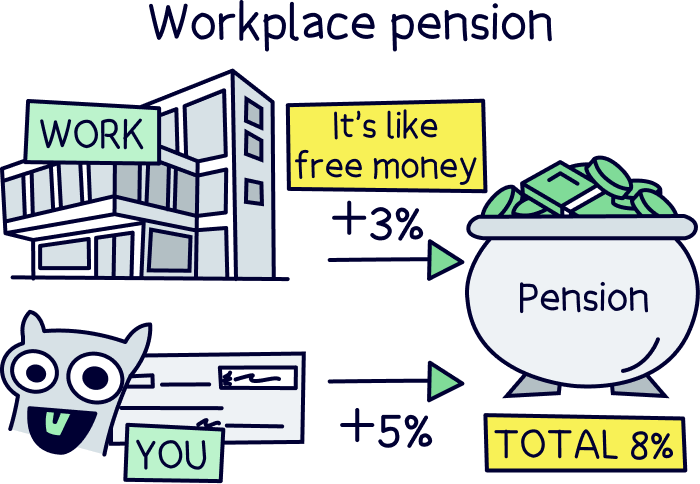
However, you don’t get to choose which pension provider (pension company) you use, and often these aren’t the best – they can have high fees, and poor investment performance. Your employer decides which one you have to use.
Imagine being on a mobile phone contract that you’re not happy with, with all these great deals out there, but you’re stuck on an expensive deal that you can’t change (until you leave your job). That’s all different with a personal pension…
Personal pensions are a great way to boost your pension savings further alongside a workplace pension (if you’re employed), and pretty much your only option if you’re self-employed.
Nuts About Money tip: if you are self-employed, here’s our guide to the best self-employed pensions.
They’re pretty amazing too – you decide which pension provider you want to use, how much you’d like to pay in, and when (we recommended a set amount you can afford every month) – which can be changed, paused or stopped any time.
And for every time you do pay in, you’ll get a massive 25% bonus added automatically from the Government (we’re not joking!).

If you’re a higher rate taxpayer (earning over £50,270 per year and paying 40% tax), or an additional rate taxpayer (earning over £125,140 per year, and paying 45% tax), you can claim back some of the tax paid at those rates too (you do this through the government tax relief service or on your Self Assessment tax return if you do one).
This is called tax relief. Saving into a pension is intended to be tax-free, however you’ve already paid tax on your income (directly from your salary), so this is like a refund of the tax you’ve paid.
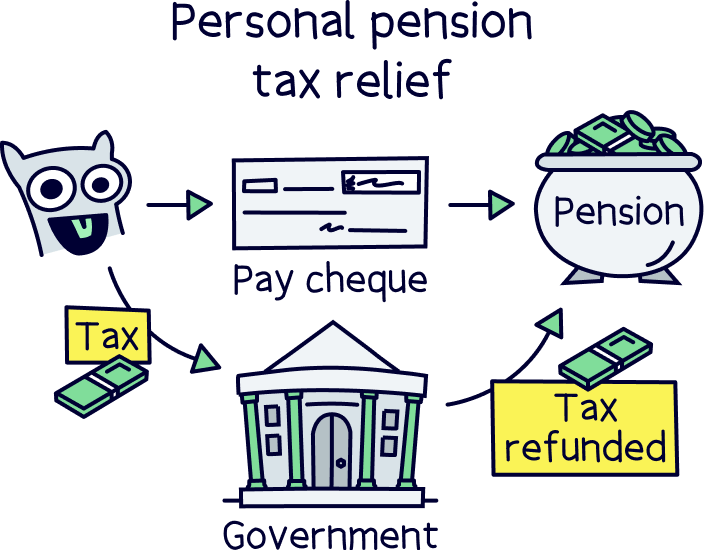
Now it gets a bit more complicated, your personal pension can be managed by experts, who will look after and grow your money over time, all ready for retirement (this is often called a pension fund). This is the most common option (and highly recommended). Not sure where to look? Here's our top personal pensions.
Or, you can manage the investments yourself, which is called a self-invested personal pension (SIPP). Typically, we only recommend these for experienced investors. If they sound interesting, check out the best SIPP providers.
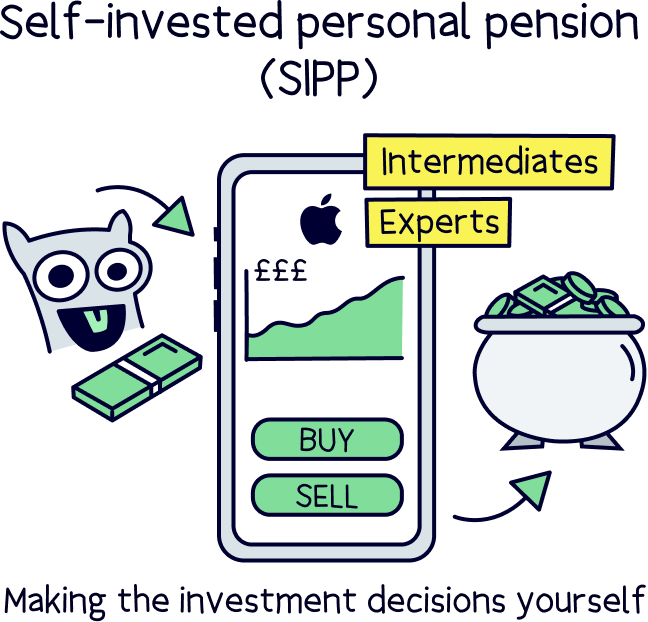
One last little bit of information about the different types of pension saving – the pensions mentioned above are called defined contribution pensions, which are where you save money yourself, and build up a big pension pot, ready for retirement.
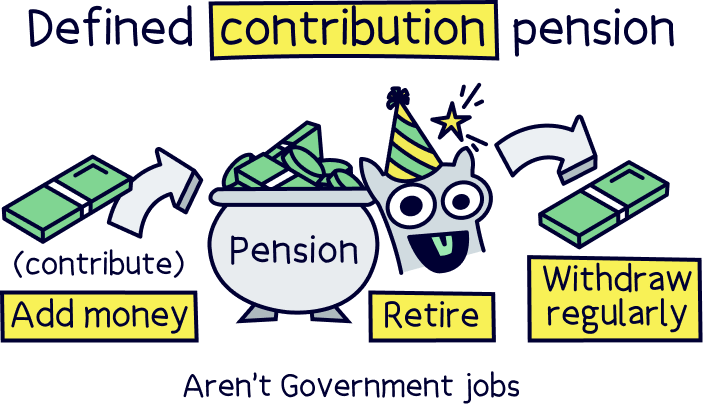
The alternative is a defined benefit pension scheme, which are common in government workplaces, such as the NHS, where you get a set income when you retire, based on things like how long you’ve worked there, and your salary. These can often be called a final salary pension.
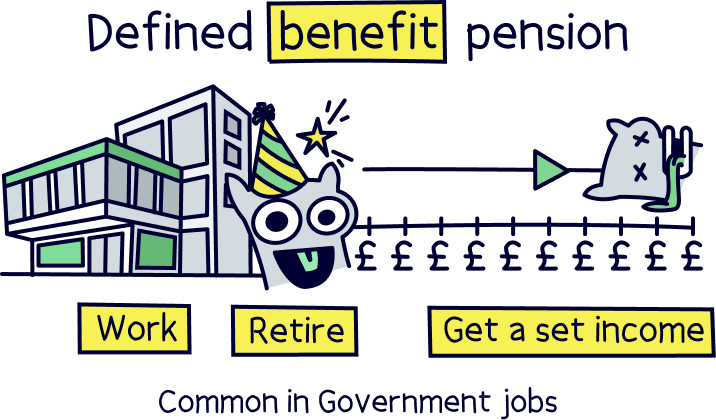
It’s still a good idea to boost your pension pot with a personal pension if you do have a defined benefit pension.
Before you get carried away, it’s good to know that you can only save as much as your total income per tax year (April 6th to April 5th the following year), or up to £60,000, whichever is lower. This is in total across all your pensions (workplace pension and personal pension).
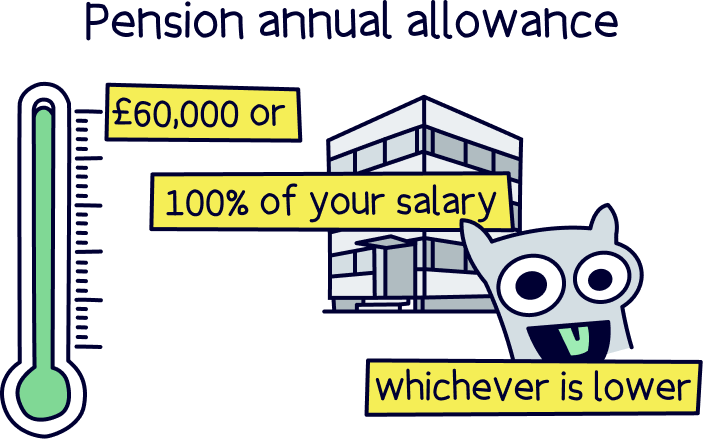
And as we’ve mentioned, it’s locked away until you’re at least 55 years old (57 from 2028).
One of the great things about pensions (alongside the 25% bonus), is that your money grows tax-free – so you don’t need to worry about tax at all (until you retire), this means your money can grow much faster over time too!
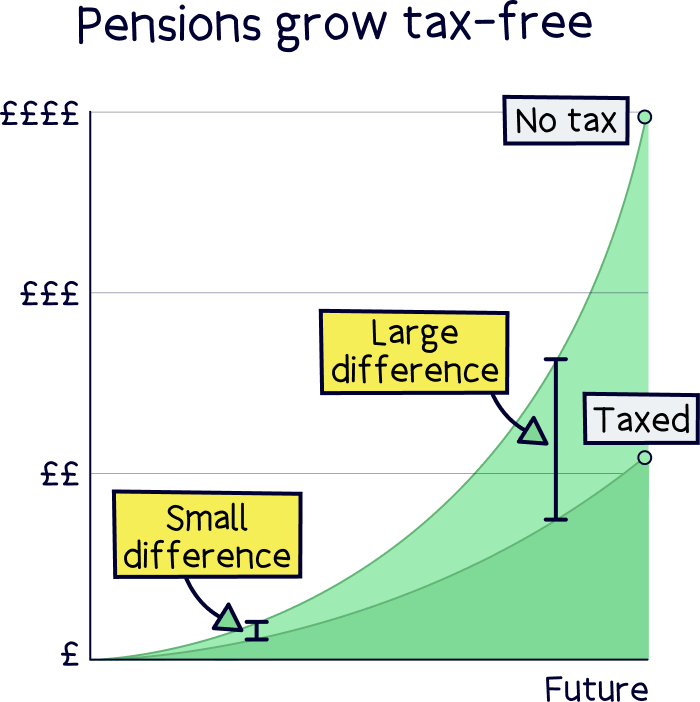
Finally, when you do want to retire, 25% of it will be completely tax-free (whoop!). The remaining 75% will be liable for Income Tax, which is the same tax as you pay on your salary now (or self-employed income). The amount you’ll pay will depend on your income at the time.
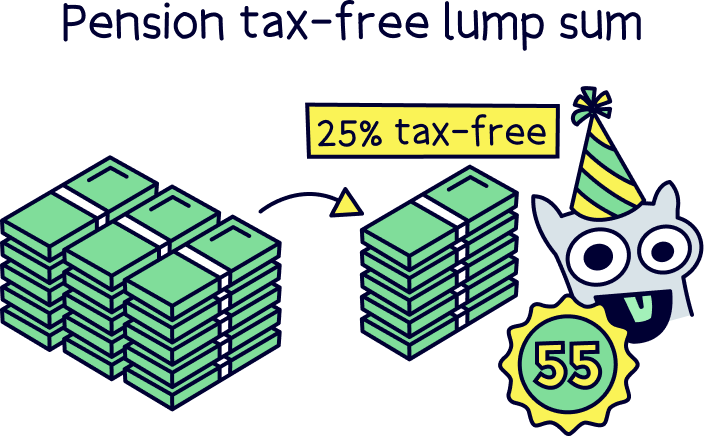
Here’s the best way to save for retirement, in 5 easy steps:
If you are employed, you’ll likely have a workplace pension, with all your pension contributions taken from your salary.
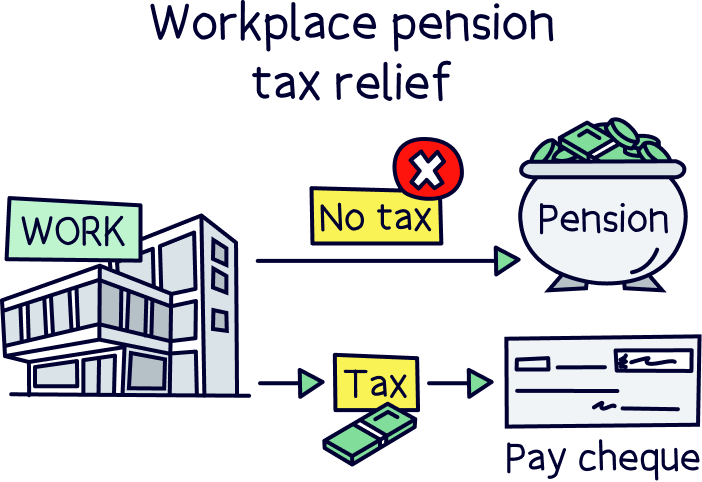
You’re probably making the most of it already, by paying in 5% of your salary per year, which means your employer has to pay in 3% per year too – however, some employers will actually contribute more, if you contribute more yourself, so even more free money.
If you’re working for a nice employer who does this, make the most of it, and contribute the minimum amount you need to get the extra free cash! It will really add up over time.
Once your workplace is sorted (if you’re employed), or if you’re self-employed, it’s time to start saving directly into a personal pension – this will boost your total pension pot a lot over time, and even saving a small amount can add up (remember the compound interest we mentioned above?).
You’ve got to decide if you want to let the experts manage your investments, or make them yourself – we strongly recommend simply letting the experts handle things. They know what they’re doing, and use sensible investment strategies aimed at growing pensions over time.
Our recommended option for an expert-managed pension provider is PensionBee¹ – it’s easy use, low cost and has a great track record of growing money over time. Also check out Beach¹, it's an easy to use pension with a great app, add money or combine old pensions (and find lost pensions), plus, the customer service is excellent.
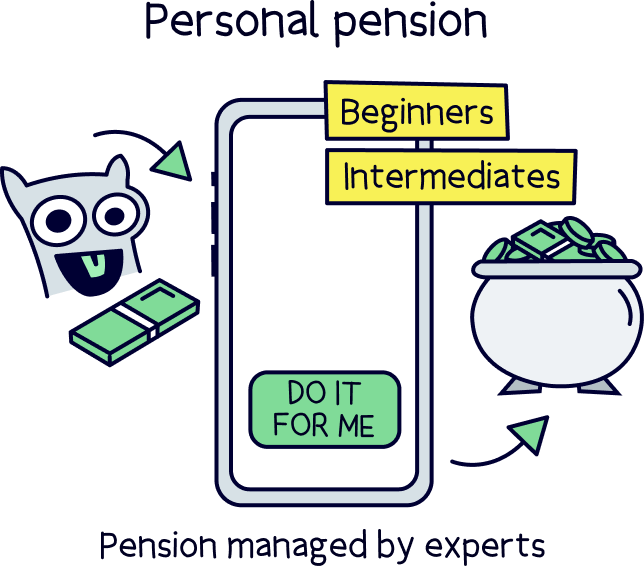
You can also check out the full range of options with our best pension providers.
If you do want to make your own investments check out the best SIPP providers.
Next up, pick the right pension plan for you (don’t worry it’s easy). You can always change your mind later on too.
If you’re using an expert-managed pension provider, such as PensionBee¹, you’ll have the choice of a few simple, Beach¹ only has one option and it's based on your age. And if you’re making your own investments with a SIPP, the world’s your oyster (although we recommend a sensible pension fund).
Typically, your options will be based on how long you’ve got left until retirement. If you’re quite far off (more than 5 years), most people would tend to opt for a higher risk plan – that’s where your money can grow much more over time, but there can be bigger ups and downs along the way.
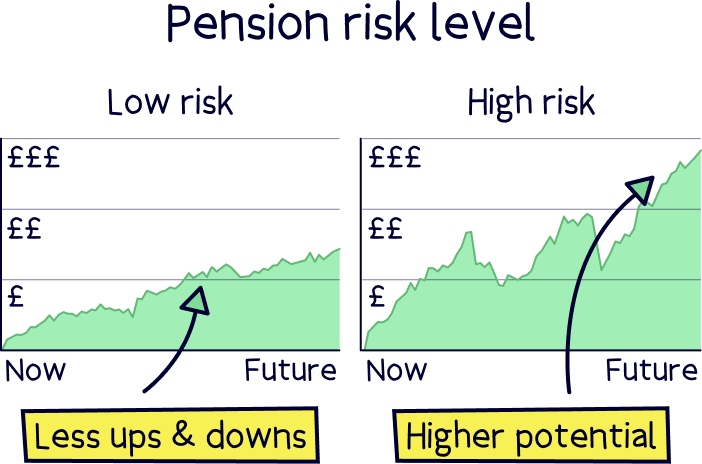
If you’re nearing retirement, it's often a good idea to reduce the level of ups and downs, and opt for a lower risk plan, so you have a bit more control over how much money you'll retire with.
If you’re a bit unsure, your expert-managed provider can typically help out too, and you’ll normally be guided to the right plan for you when you sign up.
Now here’s a really important bit – get saving! Save as much as you comfortably can, but remember you can’t access your cash until you’re at least 55 years old (57 from 2028).
Ideally, you’ll want to set up a monthly contribution into your personal pension – see how much you can put away, and then aim to grow it over time if you can afford to. We’ll cover how much you might want to aim for below.
As mentioned (a few times!), you'll automatically get a massive 25% bonus on your contributions, every time you pay in, so you really are getting more free cash if you save more – and this compounds over time to become some seriously big numbers!
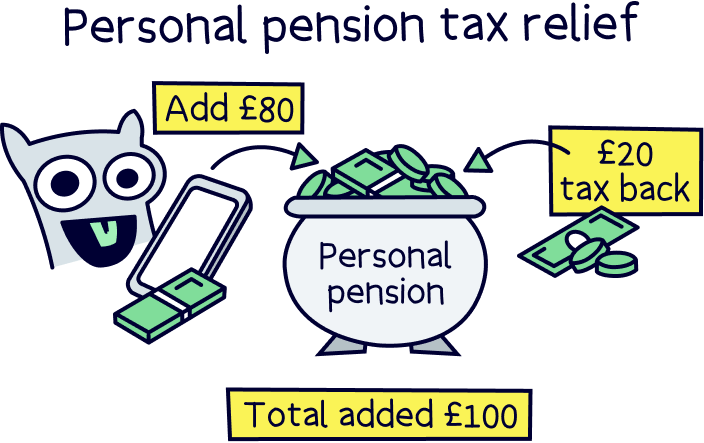
Now patience is key. Remember we’re saving for your retirement – and it could be many years away.
If you’re all set up with a decent monthly retirement savings plan, simply try and forget about it, and enjoy life!
You’ll be all good for retirement, and your pension should grow over time thanks to your contributions, the bonus from the Government, and the investment growth too – all 3 work great together, and really can give you the retirement you can dream of.
After 55, you can start withdrawing your money if you want – although it’s often a good idea to let this keep growing until you actually retire to give you a bigger retirement income (you don't want to be working forever).
To work out how much you’ll want to be saving into your pension, let’s take a look at something called the Retirement Living Standards. These are guidelines for how much annual income you’ll need in retirement – and produced by the Pensions and Lifetime Savings Association.
They’re broken down into 3 key categories: minimum, moderate and comfortable.
Minimum: this is just getting by, without a car, and just enough for food.
Moderate: this is living life a bit more, running a cheap car, and one holiday in Europe per year.
Comfortable: this is a slightly better car, more money for bills and food, and a nicer holiday in Europe.
By the way, the Retirement Living Standards assumes you won’t be paying rent, and have paid off your mortgage. If you think you’ll be paying these costs, add more to these estimates.
Here’s how much you’ll need as a retirement income:
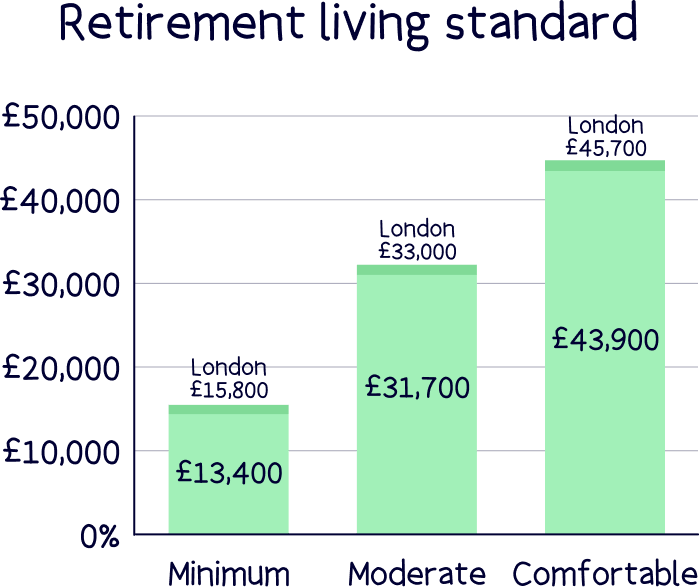
Was it around what you had in mind? It’s a fair bit isn’t it? And if you think you’ll want more luxuries, you’ll need to save even more.
To get the level of retirement income you’d like in the future, here’s how much you’ll need in total by the time you retire:
It’s a lot isn’t it? But don’t worry, you don't have to actually save these numbers, as you will have help from the bonus, your pension making money and compounding interest over time. These numbers can be achieved if you follow our advice above.
Over time, your money can really build into some staggering amounts – the trick is to get started as soon as you and save regularly (sorry to sound like a broken record).
If you’re keen to learn more about these numbers, check out our guide to how much you’ll need in your pension pot.
Finally, here’s how much you’ll need to save into your pension per month, and want to retire at 68 (the age the State Pension is likely to be in the future).
Figures include receiving the State Pension.
Figures include receiving the State Pension.
Figures include receiving the State Pension.
As you’d probably guessed, how much you’ll need to save every month grows every year you don’t get started!
These figures presume you haven’t got a pension pot at all yet, so if you do, you can save less.
As a quick overview, at 25, you need to save around £140 per month to achieve the minimum standard of living in retirement, £880 for a moderate income, and £1,370 per month for a comfortable retirement.
It’s a lot isn’t it? This is the total from all of your pensions, and includes any bonus from the Government (when you pay into a personal pension), and the extra 3% of your salary from your employer (if you have one).
So, how much you need to put away into a personal pension can be quite a lot less than these numbers. The important thing is not to be put off, save as much as you comfortably can, it can really grow over time.
If you’re ready to get started saving, we recommend using PensionBee¹ – it’s easy to use, low cost and a great track record of growing money over time. Here's all our top pension providers.
You might have some old pensions lying around collecting dust – perhaps from old jobs that you’ve moved on from. Well don’t just let them sit there! If you didn’t know, you can move them to another provider of your choice.
If you do have any, do you know how much there is? How they’re performing, or how much the fees are (taken from your pension pot directly)?
You can move them over to your new personal pension, called consolidating your pension, or a pension transfer, so you can have all your pension pots in one place – making it far easier to manage, and not forget about in years to come!
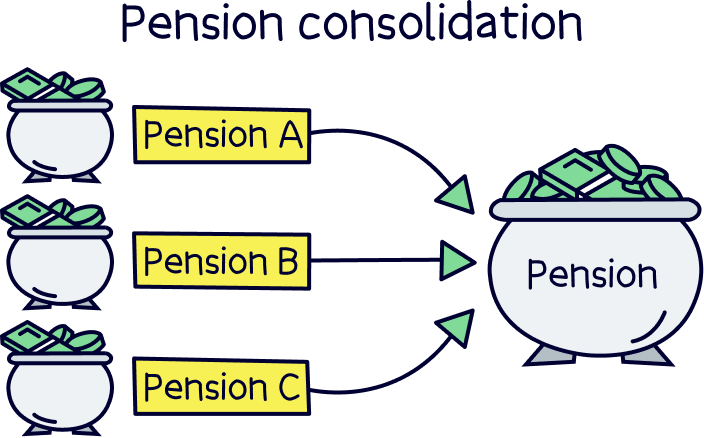
You could also benefit from lower fees, and better investment performance over time too.
If you have got some old pensions, and if you use a great modern provider, such as Beach¹ they’ll move your old pensions into your new pension, for free. All you need to do is let them know who your old provider is.
If you’re not sure who your provider is, check with your old HR department, or try Beach¹, they might be able to help find them.
You may have heard of some other types of savings accounts, but really nothing compares to a pension. Let’s quickly run through them.
A Lifetime ISA (LISA), is intended to save for your first home, and you can save up to £4,000 per year, and you’ll get a 25% bonus from the Government. You can buy a home for up to £450,000.
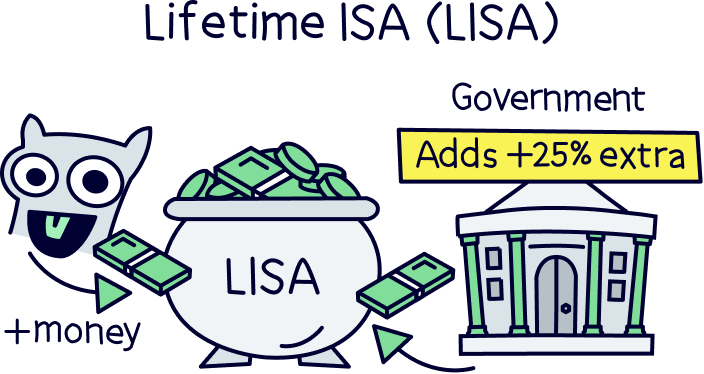
However, if you don’t use it for your first home, you can instead keep saving into it, and eventually withdraw the cash when you’re 60 years old. If you withdraw before the age of 60, you’ll have to pay a hefty 25% charge (which is more than the original bonus).
That means sometimes it can be used for retirement savings, however, there’s not really any benefit to actually doing this for most people, as a pension has the same 25% bonus, among other benefits, and there’s a lot fewer restrictions. You also then can’t use it for your first home!
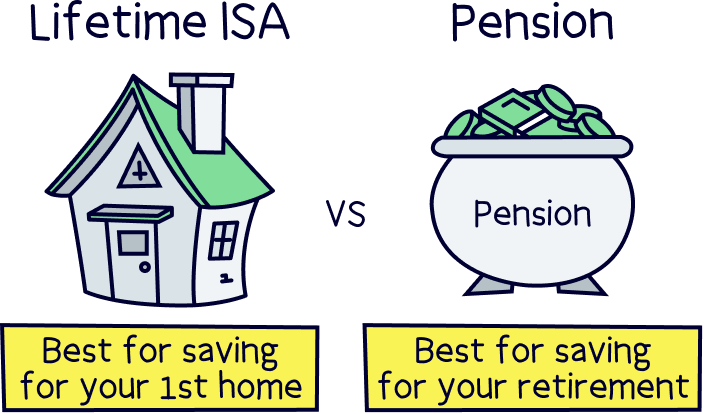
You can learn more with our guide to a Lifetime ISA vs pension, and if these sound interesting, here’s the best Stocks and Shares Lifetime ISAs.
You also have the option to save within a Stocks and Shares ISA (Individual Savings Account). This is where you can save and invest up to £20,000 per tax year (April 6th to April 5th the following year), and everything you make is tax-free forever! You can withdraw it whenever you like too (unlike a pension).
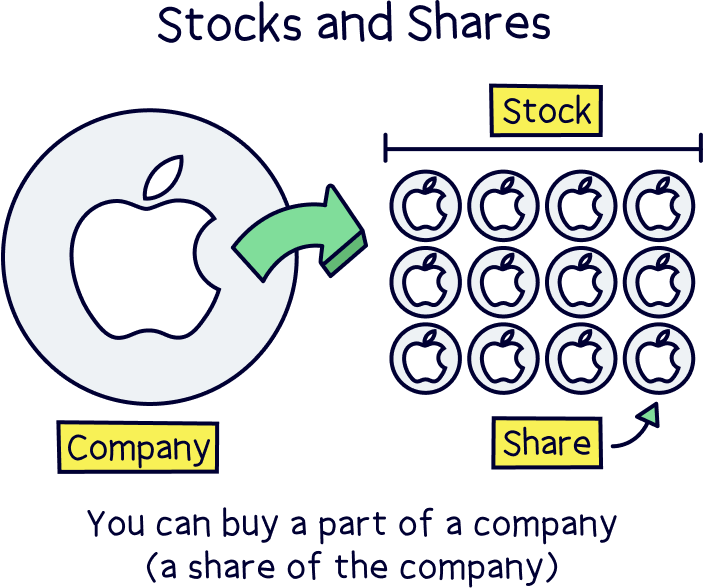
However, you won’t benefit from the government bonus (25%), or claiming 40% or 45% tax back (if you pay those amounts on your annual income) – so your money will grow much slower over time. If you’re investing over a long period of time, like for your retirement, this bonus can really add up – so it’s still far better to invest within a personal pension.
A great savings strategy is to use a Stocks and Shares ISA for savings you might want to spend in the near future, like a wedding, and save the rest into your personal pension to save for retirement. Beach¹ actually allows you to save into a Stocks and Shares ISA and pension.
You can learn more about ISAs with our guide to the best Stocks and Shares ISAs.
Note: your £20,000 annual allowance is for all of your ISAs, for instance it includes a Cash ISA, and a Lifetime ISA, if you’re saving into those too.
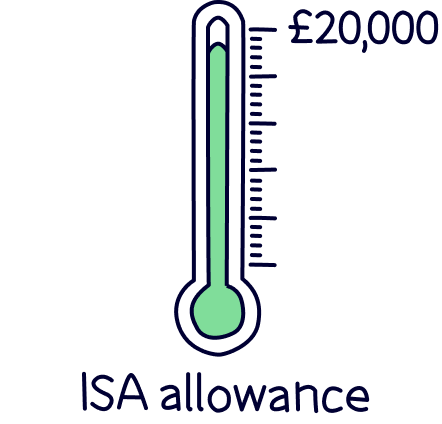
There we have it, the best way to save for retirement. Fairly easy overall isn’t it?
The hardest bit is to be consistent, remaining patient and letting time do the work – building your pension pot nice and large, while you keep paying into it as much as you can regularly. It will take a while, but down the line, you’ll really benefit – we promise! (You might even be able to quit your job and retire early. Imagine the feeling.)
As a recap, here’s the 5 steps we recommend:
So, first make the most of the free money (3%) you get from your employer (if they match more than 3% pay in more). After that, start squirrelling away monthly into a personal pension – and as much as you can comfortably afford (especially in the early days).
To help find the best pension for you, we’ve put together the best pension providers – PensionBee¹ tops the list, it’s easy to use, has low fees and a great record of growing money over time. Plus, you’ll get dedicated customer support.
Beach¹ is also great, super simple to use and has an easy access pot alongside a pension, for everyday savings. Or, you could get financial advice based on your own personal circumstances from an independent financial advisor.
And that’s it. All that’s left to say is get saving! Your future self will really thank you.
Check out PensionBee – it’s easy to use, low cost and has a great track record of growing pensions.
Check out PensionBee – it’s easy to use, low cost and has a great track record of growing pensions.
We’d love to hear from you, and it will help others too.
Check out PensionBee – it’s easy to use, low cost and has a great track record of growing pensions.